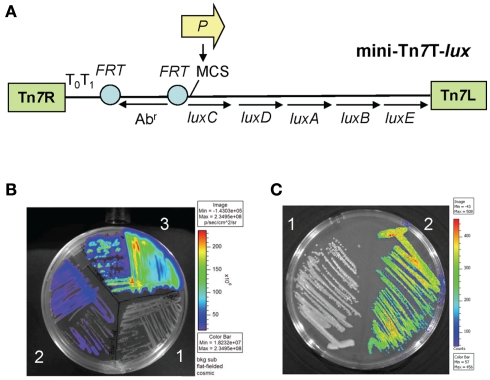Figure 7.
Bioluminescent tagging of Burkholderia spp. with mini-Tn 7-lux elements. (A) Map of a typical mini-Tn7-lux element. The basic element contains a promoter-less P. luminescens luxCDABE operon that is preceded by a multiple cloning site (MCS). An antibiotic resistance (Abr) selection marker inserted upstream of the lux operon is preferably flanked by yeast Flp recombinase target (FRT) sites that allow optional site-specific excision of the Abr marker after site-specific insertion into the bacterial chromosome. Restriction sites in the MCS can also be used to insert customized promoter sequences (arrow labeled P). (B) A mini-Tn7-lux element with a zeocin resistance selection marker was inserted into the glmS1-associated insertion site of chromosome 1 of B. thailandensis strain E264 (Choi et al., 2005). Bacteria containing either no insertion (1), a promoter-less mini-Tn7-lux (2) or a mini-Tn7-P1-lux element where the lux operon is transcribed from the strong P1 integron promoter (DeShazer and Woods, 1996) were grown overnight on an LB plate and imaged on an IVIS Spectrum imaging system. (C) A mini-Tn7-lux element with a gentamicin resistance selection marker was inserted into the glmS3-associated insertion site on chromosome 2 of B. pseudomallei strain Bp340 (Choi et al., 2008; Mima and Schweizer, 2010). Bacteria containing either no insertion (1) or a mini-Tn7-lux element where the lux operon is transcribed from synthetic promoter sequences active in B. pseudomallei (2) were grown overnight on an LB plate and imaged on an IVIS Spectrum imaging system.

